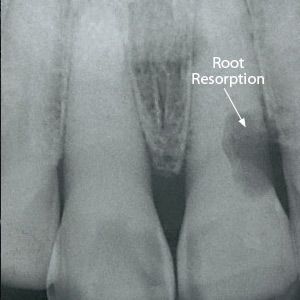
When primary (“baby”) teeth begin to give way for incoming permanent teeth, their roots dissolve in a natural process called root resorption. Dissolving roots, however, isn’t natural for adult teeth — in fact, this uncommon phenomena endangers the tooth.
While abnormal root resorption can begin inside the tooth, most occurrences start outside and work their way in around the cervical (“neck-like”) region near the gum line. The beginning stages of what’s called External Cervical Resorption (ECR) are characterized by pink spots on the tooth surface where weakened enamel fills with pink-colored gum tissue cells that are causing the damage. The spots soon develop into holes as the roots resorb.
We don’t know the exact causation for ECR, but there are factors that may make someone more likely to develop it. The tooth may have been subjected at some point to excessive orthodontic force or some other trauma that damaged the periodontal ligament, which is part of the mechanism for laying down new bone cells when teeth move. Grinding habits or internal bleaching procedures may also contribute to the condition, although these are considered rare factors.
Once detected, it’s imperative we treat ECR immediately to keep the damage from rapidly progressing. Small lesions can be accessed with gum surgery where the damaging cells are removed and the area filled with a tooth-colored filling. Another option for a single affected tooth is to orthodontically move it gradually from the jawbone before surgery. The surrounding gum tissue will move along with it and prompt the creation of new bone around the tooth. This will help match up the gum tissue height of the adjacent teeth so that after treatment the appearance of gum recession is avoided.
More extensive treatments like a root canal may be needed the more ECR progresses. There is a point, however, where the damage may be too great. In these cases, the best approach is to remove the damaged tooth and replace it with a dental implant or similar restoration.
It’s therefore best to uncover the condition as early as possible: be sure you keep up regular dental checkups and cleanings. And if you see anything out of the ordinary in your teeth’s appearance, see us as soon as possible to have it checked.
If you would like more information on root resorption in adult teeth, please contact us or schedule an appointment for a consultation. You can also learn more about this topic by reading the Dear Doctor magazine article “Root Resorption.”
